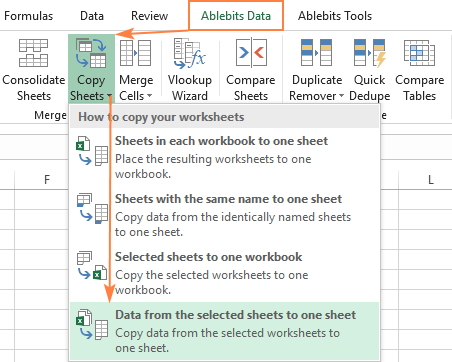

- #EXCEL MERGE WORKBOOKS INTO ONE UPDATE#
- #EXCEL MERGE WORKBOOKS INTO ONE DOWNLOAD#
Then I have another spreadsheet for shipment in Aug. So that spreadsheet would have a column for Item #, Item Name, and a Qty. Imagine that I have a spreadsheet which is a list of items that a customer ordered for shipment in July. I thought it was similar enough to your example but actually it’s not quite. Thanks for the reply! Unfortunately my issue is a bit more complex than I led on.
#EXCEL MERGE WORKBOOKS INTO ONE DOWNLOAD#
The best way to learn is to practice yourself, so click the link below to download the Excel 2010 workbook used to show the methods described in this post. It’s important to remember that the space to contain the merged data should be blank, since Excel will automatically overwrite anything it finds in that space when it completes the merge.Excel automatically includes the file path in the Reference box followed by an exclamation point. If the data you want to consolidate is contained in separate workbooks, you can simply select the Browse… button to find that workbook, then click OK to close the Browse dialog box.
#EXCEL MERGE WORKBOOKS INTO ONE UPDATE#
If you select the Create links to source data option, Excel will automatically update the newly consolidated data on the Merged Master worksheet whenever you update any of the source values from the other worksheets. Viola!Įxcel automatically summed the data from all three worksheets, sans formulas or VBA. When you click OK Excel will complete the merge, and the Merged Master worksheet will now contain the consolidated first quarter sales for each employee. Your Consolidate dialog box should now look like this: This time when you click the February worksheet you’ll notice the same range appears in the dialog box, except it’s been updated to February instead of January. Click Add to include this range in the All References box. You’ll see the range you just selected now appears in the Reference box. Under Reference click the small button, then select the January worksheet, select cell B5, press Ctrl + Shift + ↓ + → to select the entire data range (B5 through G35) and press Enter. We’ll leave the default, Sum, since we’re looking to sum the sales from January, February and March, but I suggest trying out different functions ( Count, Average, Max, Min, etc.) to see what they do. In the Consolidate dialog box that appears, under Function, choose the summary function thatyou want Excel to use to consolidate your data. The newly created “Merged Master” worksheet should have the same layout, but without any data. Select cell B5, press Ctrl + Shift + ↓ + → to select the entire data range (B5 through G35). Press Delete. Double-click on the newly created January (2) worksheet, type “Merged Master” and press Enter. Right click on the January worksheet and select Move or Copy…. This worksheet should look identical to the other worksheets (same columns, rows and layout) except the space to contain the mergeddatashould be blank. The only difference between the worksheets to merge is the data contained within these columns and rows.Īll worksheets to merge should have the same layout. For example, notice that the January, February, and March worksheets all have the same columns and rows in the same layout. Ensure that the worksheets you intend to merge all have the same columns and rows in the same order. There are 30 employees and three separate worksheets (one for January, February and March), each containing the total cars sold that month per employee, per car. The file I’m working with, which you can download here or at the end of this post, is for a fake used car dealership that sells the Honda Accord, Honda Civic, Toyota Corolla, Toyota Matrix and Toyota Camry. Merge worksheets that were previously distributed among colleagues or other groups of people for updating back into one master worksheet. Roll up sales from multiple customers, products, months, quarters, years, and so on. 
 Roll up expenses from multiple offices, branches, employees, children, etc. Here are some typical cases where this feature comes in handy: Best of all, it requires no formulas, macros or VBA code. Lucky for you, Excel has a neat little Consolidate feature that’s powerful, flexible and very easy to use. How do you merge multiple Excel worksheets into one master worksheet, automatically, and without macros or VBA? Down the line I’ll discuss other methods to merge and consolidate data in Excel, but today I’m focusing on this particular situation: you have more than one worksheet, all formatted with the same columns and rows, but each worksheet contains different data that you want to pull together and summarize. Today I’m tackling a common problem that’s plagued office heroes for years.
Roll up expenses from multiple offices, branches, employees, children, etc. Here are some typical cases where this feature comes in handy: Best of all, it requires no formulas, macros or VBA code. Lucky for you, Excel has a neat little Consolidate feature that’s powerful, flexible and very easy to use. How do you merge multiple Excel worksheets into one master worksheet, automatically, and without macros or VBA? Down the line I’ll discuss other methods to merge and consolidate data in Excel, but today I’m focusing on this particular situation: you have more than one worksheet, all formatted with the same columns and rows, but each worksheet contains different data that you want to pull together and summarize. Today I’m tackling a common problem that’s plagued office heroes for years.







 0 kommentar(er)
0 kommentar(er)
